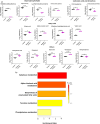Low-Dose Radiation Induces Alterations in Fatty Acid and Tyrosine Metabolism in the Mouse Hippocampus: Insights from Integrated Multiomics
- PMID: 39185768
- PMCID: PMC11413841
- DOI: 10.1021/acschemneuro.4c00231
Low-Dose Radiation Induces Alterations in Fatty Acid and Tyrosine Metabolism in the Mouse Hippocampus: Insights from Integrated Multiomics
Abstract
In recent years, there has been a drastic surge in neurological disorders with sporadic cases contributing more than ever to their cause. Radiation exposure through diagnostic or therapeutic routes often results in neurological injuries that may lead to neurodegenerative pathogenesis. However, the underlying mechanisms regulating the neurological impact of exposure to near-low doses of ionizing radiation are not known. In particular, the neurological changes caused by metabolomic reprogramming have not yet been elucidated. Hence, in the present study, C57BL/6 mice were exposed to a single whole-body X-ray dose of 0.5 Gy, and 14 days post-treatment, the hippocampus was subjected to metabolomic analysis. The hippocampus of the irradiated animals showed significant alterations in 15 metabolites, which aligned with altered tyrosine, phenylalanine, and alpha-linolenic acid metabolism and the biosynthesis of unsaturated fatty acids. Furthermore, a multiomics interaction network comprising metabolomics and RNA sequencing data analysis provided insights into gene-metabolite interactions. Tyrosine metabolism was revealed to be the most altered, which was demonstrated by the interaction of several crucial genes and metabolites. The present study revealed the regulation of low-dose radiation-induced neurotoxicity at the metabolomic level and its implications for the pathogenesis of neurological disorders. The present study also provides novel insights into metabolomic pathways altered following near-low-dose IR exposure and its link with neurodegenerative diseases such as Alzheimer's disease and Parkinson's disease.
Keywords: Alzheimer’s disease; low-dose radiation; metabolomics; neurodegeneration; neurotoxicity.
Conflict of interest statement
The authors declare no competing financial interest.
Figures




References
Publication types
MeSH terms
Substances
LinkOut - more resources
Full Text Sources

